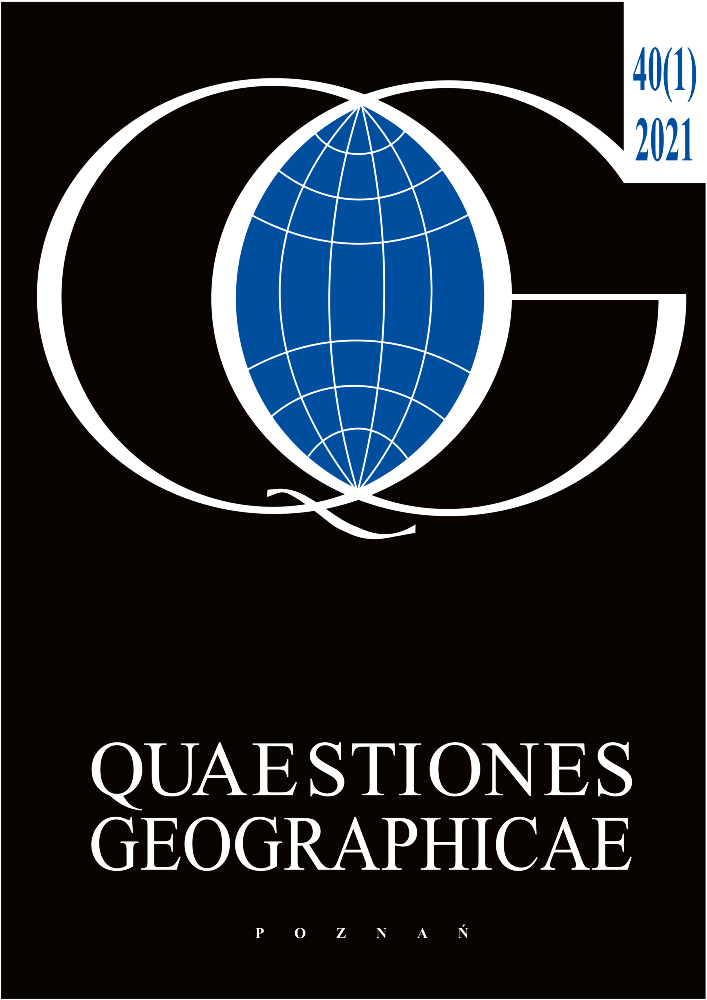Abstract
The study of internal and external factors in the formation of an urban geosystem is determined by its complex structure and multiple connections. Based on geoinformation modelling, an analysis of the landscape structure of the city territory is carried out, which can be a basis for further geoecological research. Morphometric indicators, which make it possible to determine the elementary geochemical landscapes, are indicated according to the data of the digital elevation model. A standardised topographic position index (TPI) is used to determine locations. Spatial zoning according to the type of land use reflects the qualitative features of the external load and technogenic impact. The data on the composition of the lithogenic base show the properties of the depositing medium and determine the natural background. Number of categories of landscapes identified are 58, characterised by a homogeneous geological composition, technogenic load and conditions for the migration of matter. The ratios of various landscape zones have been calculated. The study area as a whole is characterised by the predominance of migration processes over accumulation.
Funding
The study was carried out according to the program of the Institute of Geology of the Karelian Research Center АААА-А18-118020690231-1. The authors thank the reviewers for their remarks and comments on the work.
References
De Ferranti J., 2014. Digital elevation data. Online: http://viewfinderpanoramas.org/dem3.html (accessed 15 December 2020).
De Reu J., Bourgeois J., Bats M., Zwertvaegher A., Gelorini V., De Smedt Ph., Chu W., Antrop M., De Maeyer Ph., Finke P., Van Meirvenne M., Verniers J., Crombé Ph., 2013. Application of the topographic position index to heterogeneous landscapes. Geomorphology 186: 39–49. DOI 10.1016/j.geomorph.2012.12.015.
Drǎguţ L., Blaschke T., 2006. Automated classification of landform elements using object-based image analysis. Geomorphology 81(3–4): 330–344. DOI 10.1016/j.geomorph.2006.04.013.
Evans I. S., 2012. Geomorphometry and landform mapping: What is a landform? Geomorphology 137(1): 94–106. DOI 10.1016/j.geomorph.2010.09.029.
Florinsky I.V., 2012 Morphometric variables. In: Digital terrain analysis in soil science and geology. 7–30. DOI 10.1016/b978-0-12-385036-2.00002-x.
Gallant J.C., Wilson J.P., 2000. Primary topographic attributes. In: Wilson J.P., Gallant, J.C. (eds), Terrain analysis: Principles and applications. Wiley, New York: 51–85.
Glazovskaya M.A., 1988. Geochemistry of natural and technogenic landscapes of the USSR, High school, Moscow: 327.
Jones K.L., Poole G.C., O’Daniel S.J., Mertes L.A.K., Stanford J., 2008. Surface hydrology of low-relief landscapes: Assessing surface water flow impedance using LIDAR-derived digital elevation models. Remote Sensing of Environment 112(11): 4148–4158. DOI 10.1016/j.rse.2008.01.024.
Klingseisen B., Metternicht G., Paulus G., 2008. Geomorphometric landscape analysis using a semi-automated GIS-approach. Environmental Modelling and Software 23(1): 109–121. DOI 10.1016/j.envsoft.2007.05.007.
Krenke A.N., Puzachenko Yu. G., 2008. Construction of a map of the landscape cover based on remote sensing information. Environmental Planning and Management 2: 10–26.
Krutskikh N.V., Borodulina G.S., Kaznina N.M., Batova Yu., Ryazantsev P.A., Akhmetova G.V., Novikov S.G., Kravchenko I.Yu., 2016. Geoecological basis for setting up the monitoring of urbanized areas in the north (the example of Petrozavodsk). Works of the Karelian Scientific Center of the RAS 12: 52–67.
Krutskikh N.V., Kosinova I.I., 2014. Methodology division of urban areas according to ecological-geochemical studies (on example of city Petrozavodsk). Bulletin of Voronezh State University. Geology 3: 95–97.
Lake Onega. Atlas. 2010. Filatov N.N. (ed.), KarRC RAS, Petrozavodsk: 151
Mkrtchyan A.S., 2006. Automated selection of landscape units by classification of relief using GIS. In: Dobrolyubov S.A. (ed), Landscape Planning: General Foundations, Methodology, Technology, MSU, Moscow: 203–208.
Mokarram M., Seif A., 2014. GIS-based automated landform classification in Zagros mountain (case study: Grain mountain). Bulletin of Environment, Pharmacology and Life Sciences 3(3): 20–32.
Novakovsky B.A., Krasovskaja T.M., Tulskaja N.I., 2007. Use of digital modeling of the relief and remote sounding for actualization of small-scale landscape and ecological maps of mountain areas. Geoinformatics 4: 3–8.
Novakovsky B.A., Permyakov R.V., 2019. Integrated geoinformation and photogrammetric modeling of the relief, MIIGAiK, Moscow: 175.
Novikov S.G., 2015. Assessment of heavy metal contamination in soils of different land use types in Petrozavodsk. Works of the Karelian Scientific Center of the RAS 1: 78–85.
Piloyan A., Konečný M., 2017. Semi-automated classification of landform elements in Armenia based on SRTM DEM using K-means unsupervised classification. Quaestiones Geographicae 36(1): 93–103. DOI 10.1515/quageo-2017-0007.
Planchon O., Darboux F., 2002. A fast, simple and versatile algorithm to fill the depressions of digital elevation models. Catena 46(2–3): 159–176.
Polynov B.B., 1952. Geographic works. Geografgiz, Moscow: 400.
Quaternary deposits of Finland and the North-West of the Russian Federation and their mineral resources. Scale 1:1,000,000. 1993. Niemelä J., Ekman I., Lukashev A. (eds), Geological Survey of Finland, Kar. Scientific Center RAS, Helsinki.
Shary P., Sharaya L., Mitusov A., 2002. Fundamental quantitative methods of land surface analysis. Geoderma 107(1–2): 1–32.
Sokolov S.V., Yurchenko Yu.Yu., 2010. Digital elevation model as the basis for regionalization of territories according to the conditions of conducting geochemical works (on the example of the Small Khingan, Far East). Geoinformatics 4: 54–60.
Szypuła B., 2019. Quality assessment of DEM derived from topographic maps for geomorphometric purposes. Open Geosciences 11(1): 843–865. DOI 10.1515/geo-2019-0066.
Tagil S., Jenness J., 2008. GIS-Based automated landform classification and topographic, landcover and geologic attributes of landforms around the Yazoren Polje, Turkey. Journal of Applied Sciences 8(6): 910–921. DOI 10.3923/jas.2008.910.921.
Tokarev S.V., Roshchina K.N., 2015 Mapping elements of the earth’s surface relief using the index of the topographic position (on the example of the Crimean Peninsula). Scientific Notes of the Crimean Federal University. Geography. Geology 1(67): 64–85.
Vlasov D.V., Kasimov N.S., Kosheleva N.E., 2017. Mapping of landscape and geochemical structure of urban territory (Moscow case study). InterCarto/InterGIS 1(23): 242–255. DOI 10.24057/2414-9179-2017-1-23-242-255
Weiss A.D., 2001. Topographic position and landforms analysis, poster presentation. In: ESRI User Conference, San Diego. Online: www.jennessent.com/downloads/TPI-poster-TNC_18x22.pdf (accessed 15 December 2020).
Zhuchkova V.K., Rakovskaya E.M., 2004. Methods of complex physical and geographical research. Academy, Moscow: 368.
Zwoliński Zb., Stefańska E., 2015. Relevance of moving window size in landform classification by TPI. In: Jasiewicz J., Zwoliński Zb., Mitasova H., Hengl T., (eds), Geomorphometry for Geosciences, Bogucki Wydawnictwo Naukowe, Poznań: 273–277.

